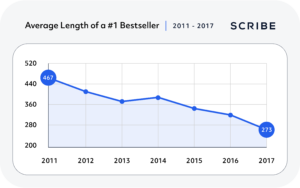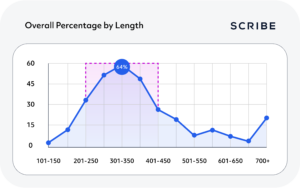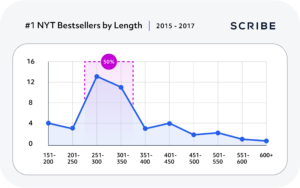A lot has been written in recent years about the average readers’ shrinking attention span.
We all know that the non-stop news cycle and round-the-clock social media have sped up our consumption habits. But do these same habits translate to books?
We decided to find out.
To get straight to the point — As recently as 2011, the average book length of the #1 non-fiction bestseller was 467 pages. By 2017, however, that number has dropped to 273 pages.
What was our methodology?
We gathered a list of every New York Times #1 Non-Fiction Bestseller for the past 7 years and analyzed how the average length has evolved.
The answer was clear: our collective cultural ADD is impacting our reading habits.
The Average Bestseller Length Is Falling Fast
Since 2011, the average length of a bestseller has dropped steadily from year to year.

The average #1 bestselling book length has fallen by 42% in just 7 years.
And this doesn’t seem to be an anomaly. The drop comes as part of a larger downward trend:
- In 2011, the list’s average length peaked at 467 pages.
- In 2012, that average fell to 410.
- In 2013, it fell further to 367.
- In 2014, it recovered slightly to 382 on the back of three 600+ page books.
- In 2015, the drop resumed as the average fell to 345.
- In 2016, the drop lessened, falling only to 342.
- In 2017, the downward trend has continued, with an average book length of 273 pages.
This isn’t to say that long books are no longer succeeding. In 2016’s list, Ron Chernow’s 816-page Alexander Hamilton managed to crack the top spot.
However, the drop in the overall average length of bestsellers over the last 7 years points to a marked trend in the overall preferences of the average reader.

#1 Bestsellers Have A Wide Range, But A Narrow Average
Since the New York Times Non-Fiction Bestseller List began in 2000, books of all sizes have claimed the top spot.
The shortest book to hit the #1 spot was Harry Frankfurt’s 80-page On Bullshit.
The longest? Robert Caro’s 1232-page tome, Master of the Senate.
Looking at this, a hopeful author might believe that length plays no role in the likelihood of a book becoming a bestseller. But while books of all sizes have cracked the list at one point or another, the vast majority of #1 bestsellers fall into a much smaller range.
Over 64% of the #1 bestsellers since the list began have fallen in the 200 to 400 page range.
In recent years (2015-2017), the trend has become even more pronounced, with over 50% of #1 bestsellers falling into the narrower 250-350 page range:

Shockingly, the 450+ page length that held the average book length just 7 short years ago, now makes up just 13% of the books in the top spot.
How to explain this dramatic shift, and whether the trend will continue, remains to be seen.


